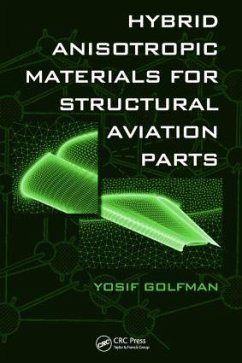As a professional in the field of composite research for 40 years, Yosif Golfman wrote this text to provide unique information on the use of anistropic materials in aerospace design. It covers nano composites, impregnation processes, and stress/strain analysis in aerospace structural engineering. It features new methods for analysis of interlaminar shear distribution in sandwich/carbon/fiber/epoxy technologies. It also discusses non-destructive methods, control technological parameters, and the influence of technological defects, such as micro-cracks, on the reduction of fatigue strength and durability. It also considers the protection of composite helicopter rotor blades by polymer coating layers.
Optimization of aviation and space vehicle design requires accurate assessment of the dynamic stability and general properties of hybrid materials used in aviation parts. Written by a professional with 40 years of experience in the field of composite research, Hybrid Anisotropic Materials for Structural Aviation Parts provides key analysis and application examples to help the reader establish a solid understanding of anisotropic properties, theory of laminates, and basic fabrication technologies. Tools to ensure cost-effective, optimized fabrication of aircraft, satellites, space vehicles, and more... With a focus on analytic modeling and dynamic analysis of anisotropic hybrid materials used in structural parts, this book assesses how and why design mechanisms either work or fail. It describes how current manufacturing techniques can apply alternative electronic and ultrasonic systems to improve the strength of an aircraft's parts, reduce vibrations, and counteract deicing effects, among other vital requirements. Presenting valuable case studies involving manufacturers such as Boeing and DuPont, this book covers topics including: Nano composites, impregnation processes, and stress/strain analysis New techniques for analyzing interlaminar shear distribution sandwich/carbon/fiber/epoxy technologies Non-destructive methods, control technological parameters, and the influence of technological defects Use of carbon-silicon nanotubes and ceramic technology Strength criteria and analysis, and composite life prediction methodologies Dynamic aspects and stability of jetliners and lattice aviation structures Interlaminar shear stress analysis and possible failure Fatigue strength and vibration analysis This volume offers a useful, informative summary of the cutting-edge work being done in the field of high-performance composite materials, including fiberglass and carbon. With coverage of topics ranging from stress analysis and failure prediction to manufacturing methods and nondestructive inspection technology, it provides unique information to benefit a new generation of composite designers, graduate students, and industry professionals working with high-performance structures.
Hinweis: Dieser Artikel kann nur an eine deutsche Lieferadresse ausgeliefert werden.
Optimization of aviation and space vehicle design requires accurate assessment of the dynamic stability and general properties of hybrid materials used in aviation parts. Written by a professional with 40 years of experience in the field of composite research, Hybrid Anisotropic Materials for Structural Aviation Parts provides key analysis and application examples to help the reader establish a solid understanding of anisotropic properties, theory of laminates, and basic fabrication technologies. Tools to ensure cost-effective, optimized fabrication of aircraft, satellites, space vehicles, and more... With a focus on analytic modeling and dynamic analysis of anisotropic hybrid materials used in structural parts, this book assesses how and why design mechanisms either work or fail. It describes how current manufacturing techniques can apply alternative electronic and ultrasonic systems to improve the strength of an aircraft's parts, reduce vibrations, and counteract deicing effects, among other vital requirements. Presenting valuable case studies involving manufacturers such as Boeing and DuPont, this book covers topics including: Nano composites, impregnation processes, and stress/strain analysis New techniques for analyzing interlaminar shear distribution sandwich/carbon/fiber/epoxy technologies Non-destructive methods, control technological parameters, and the influence of technological defects Use of carbon-silicon nanotubes and ceramic technology Strength criteria and analysis, and composite life prediction methodologies Dynamic aspects and stability of jetliners and lattice aviation structures Interlaminar shear stress analysis and possible failure Fatigue strength and vibration analysis This volume offers a useful, informative summary of the cutting-edge work being done in the field of high-performance composite materials, including fiberglass and carbon. With coverage of topics ranging from stress analysis and failure prediction to manufacturing methods and nondestructive inspection technology, it provides unique information to benefit a new generation of composite designers, graduate students, and industry professionals working with high-performance structures.
Hinweis: Dieser Artikel kann nur an eine deutsche Lieferadresse ausgeliefert werden.
